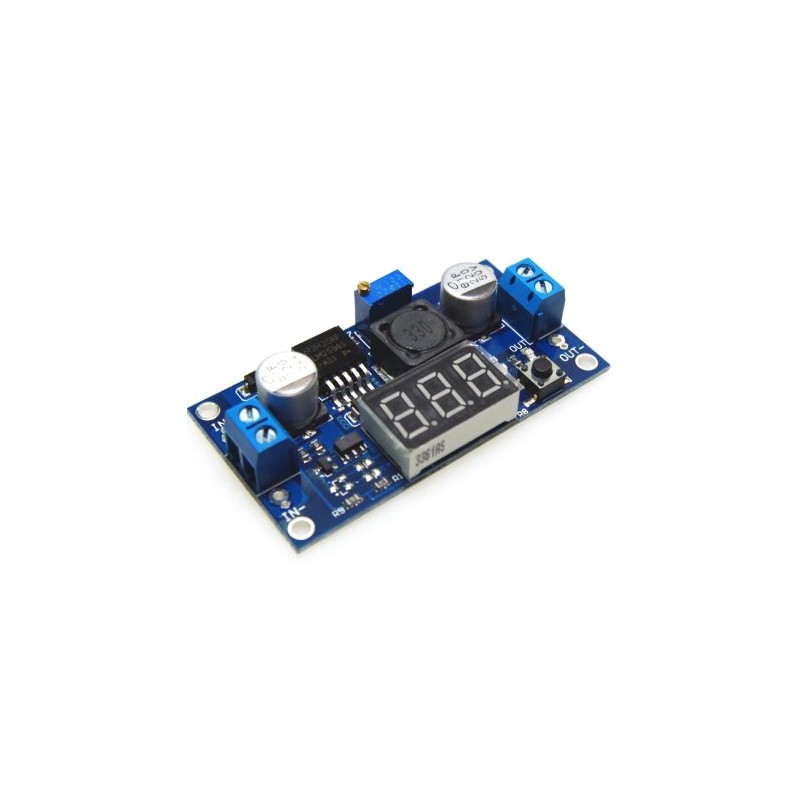



zł7.02 tax excl.
The LM2596 module with an adjustable step-down converter is a versatile tool for powering and testing electronic circuits. It allows convenient voltage adjustment with precise parameter monitoring thanks to the built-in voltmeter. Ideal for prototyping, laboratory experiments, and service work.
Adjustable module with a step-down switching converter based on the LM2596 chip, designed to reduce supply voltage in electronic projects. It allows input voltage conversion in the range of 3.2 V to 35 V to a lower, adjustable output voltage within the same range. The device is equipped with a digital LED display that enables real-time voltage reading – both input and output (switchable with a button). Thanks to high efficiency and compact design, it is suitable for workshop use and powering electronic circuits.
Data sheet
Manufacturer BTC Korporacja sp. z o. o. Lwowska 5 05-120 Legionowo Poland sprzedaz@kamami.pl 22 767 36 20
Responsible person BTC Korporacja sp. z o. o. Lwowska 5 05-120 Legionowo Poland sprzedaz@kamami.pl 22 767 36 20
Step-Down converter D36V50F5 with an output voltage of 5 V, an input voltage from 5.5 to 50 V and a maximum output current of 8 A. Pololu 4091
The compact (0.4″ × 0.5″) D24V5F1 synchronous buck voltage regulator takes input voltages between 3 V and 36 V and efficiently reduces them to 1.8 V while allowing for a maximum output current of 500 mA. This regulator offers typical efficiencies between 75% and 90%. The pins have a 0.1″ spacing, making this board compatible with standard solderless breadboards and perfboards.
This small synchronous switching step-down (or buck) regulator takes an input voltage of up to 36 V and efficiently reduces it to 9 V. The board measures only 0.7″ × 0.7″ yet delivers a typical continuous output current of up to 2.3 A and features reverse voltage protection.
No product available!
An efficient step-down converter that reduces the input voltage to 5 V at a maximum current of 100 mA, offering high efficiency due to low quiescent current (<20 μA). It supports input voltages from 5 V to 65 V, has short circuit and overheating protection, making it a reliable and energy-efficient solution. Pololu 5363
This small synchronous switching step-down (or buck) regulator takes an input voltage of up to 38 V and efficiently reduces it to 5 V. The board measures only 0.7″ × 0.8″, but it allows a typical continuous output current of up to 5 A. Typical efficiencies of 85% to 95% make this regulator well suited for high-power applications like powering motors or servos.
DC-DC step-down converter module 5V 16A used to convert energy from 6-24V input voltage to stable 5V, providing up to 16A current. Thanks to high conversion efficiency (over 90%) and low ripple (<20mV), it is ideal for powering sensitive devices in applications such as robotics, drones or LED lighting systems. Additionally, built-in overheating and short-circuit protection mechanisms ensure reliable operation even in difficult conditions. DFRobot DFR1202
Step-Down converter D36V50F6 with an output voltage of 6 V, an input voltage from 6.5 to 50 V and a maximum output current of 8 A. Pololu 4092
The Step-Down D24V3F3 Buck Voltage Regulator module gives the output voltage of 3,3V with a wide input voltage range of 4.3-42V and a maximum output current of 300 mA. Pololu 2097
No product available!
Step-Down converter D36V50F9 with an output voltage of 9 V, an input voltage from 9.9 to 50 V and a maximum output current of 7 A. Pololu 4094
No product available!
An efficient step-down converter that reduces the input voltage to 12 V at a maximum current of 100 mA, offering high efficiency due to low quiescent current (<50 μA). It supports input voltage from 12 V to 65 V, has a Power Good (PGOOD) function, an EN input for system shutdown, and short circuit and overheat protection, making it a reliable and energy-efficient solution. Pololu 5377
No product available!
The Step-Down D24V3F9 Buck Voltage Regulator module gives the output voltage of 9V with a wide input voltage range of 11-42V and a maximum output current of 300 mA. Pololu 2099
No product available!
DFRobot DFR0205 is a compact and efficient step-down DC-DC converter module with up to 25 W of power, allowing adjustment of the supply voltage to meet the needs of various electronic components. With a voltage regulation function, a quick 5 V selection switch, and an Ovout interface, it enables simultaneous power delivery to components with different voltage requirements. Ideal for prototyping, mobile projects, automation systems, and IoT applications.
DC-DC Step Down converter module with input voltage from 7 to 24 V and output voltage of 5 V. Can supply currents up to 4 A. DFRobot DFR0831
No product available!
DC-DC Step-Down converter module with 5V output voltage and 1A output current. The module can be a replacement for the popular LM7805 regulator.
No product available!
Step-Down converter D36V28F5 with an output voltage of 5 V, an input voltage from 5.3 to 50 V and a maximum output current of 4 A. Pololu 3782
Step-Down converter D36V50F7 with an output voltage of 7.5 V, an input voltage from 8.3 to 50 V and a maximum output current of 7 A. Pololu 4093

The LM2596 module with an adjustable step-down converter is a versatile tool for powering and testing electronic circuits. It allows convenient voltage adjustment with precise parameter monitoring thanks to the built-in voltmeter. Ideal for prototyping, laboratory experiments, and service work.
